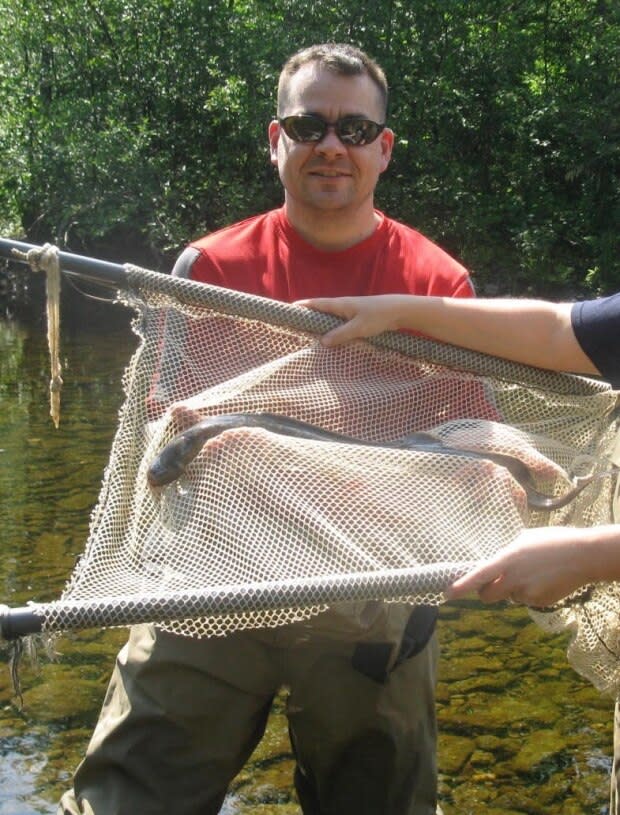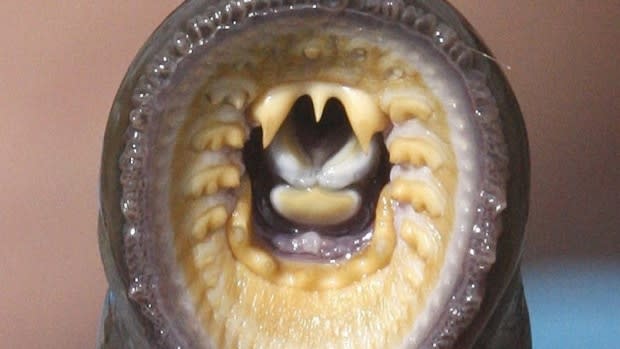'Tis the season for alien-like fish to spawn and die in N.B. fresh water
It could be right out of a Stephen King novel — or maybe just the next chapter of 2020, the one that follows COVID-19 and murder hornets.
A fish with a powerful suction cup of a mouth filled with circular rows of horn-shaped teeth and a tongue that burrows into the body of the host so it can feed at will.
A sea lamprey might strike fear into anyone who sees pictures of its horror show of a mouth.
But this alien-like fish is not the latest in a series of too-strange-to-be-true occurrences in recent months.
"I definitely wouldn't say this is a new occurrence," says Kurt Samways, a freshwater ecologist and Parks Canada research chair at the University of New Brunswick.
"Lamprey have been around for a very, very long time."

If people have noticed them more recently, it's probably because it's been spawning season, said Samways, who has been studying lamprey since 2008.
"Otherwise, I would say that they just happened to stumble upon them when they were, you know, out in the woods, out in the rivers enjoying nature and they just happened to be there at the right place, right time."
Starting in June, lamprey return from the Atlantic Ocean to spawn in fresh water. Generally, said Samways, it lasts about a month.
Although they resemble eels, they are not related. According to the Great Lakes Fishery Commission's website, they "are set apart by their unique mouth: a large oral sucking disk filled with sharp, horn-shaped teeth surrounding a razor sharp rasping tongue."

They attach to host fish and then feed at will as the host goes on with life.
Samways understands the revulsion that many people feel toward the lamprey.
"I see that side. I mean you look at them and they do have this menacing mouth and everything. I think they're fascinating creatures. I mean they are this ancient fish, they have a very unique oral disc mouth with many rows of teeth. They do look almost alien-like but they're … a fascinating creature."
Quincy Hall doesn't share Samways's affection for sea lamprey.
Seven years ago, while swimming with her family in Belleisle Bay, Hall was bitten by one.
She didn't get into the water for the rest of that summer — nor the next one. To this day, she's leery about lamprey when she swims.
"So I had literally just gotten in the water and I must've jumped near it or something and scared it, and it just was this immediate feeling of like, sharpness on my knee because that's where it bit me. And then when I kicked, I felt the slimy, like snake feeling on my other foot. That's all I felt. And that was it."
She was left with a semicircle ring of teeth marks on her leg. She suspects that the fish hadn't actually tried to latch onto her.

Samways said while bites do occur, they are rare in fresh water and usually occur when lamprey are startled or frightened.
Normally, he said, lamprey do not feed in fresh water. For the first few years of their life, they're primarily filter feeders before they undergo a metamorphosis that turns them into a parasitic feeder. At that point, they move to the ocean to feed until they're ready to spawn.
That's when they return to fresh water, and as soon as they spawn, they die.
And that is one of the reasons they are so ecologically important to marine life in Atlantic Canada, said Samways.
"When they come back to spawn, they bring a lot of nutrients with them," he explained.
"I think many people are familiar with the story of Pacific salmon coming back in really big numbers spawning. After they spawn, they all die, and so it's like truckloads of fertilizer being deposited into the rivers and those nutrients are really important for freshwater productivity on the East Coast."
Lamprey are especially beneficial for salmon, said Samways. Not only do they provide nutrients for young salmon to feed on, they create the perfect habitat for salmon to lay their eggs.
Great Lakes problem
Sea lamprey have become a huge problem in the Great Lakes region, where they are killing native species.
Samways said East Coast says lamprey don't typically kill their hosts, thanks to evolving alongside other native species. But that hasn't happened in the Great Lakes, so native species haven't learned to co-exist with lamprey and often die — either directly from the attack or from infection or malnutrition after the lamprey have finished with them.
"They're native to Atlantic Canada, so all the species of fish here, they evolved with them. And so we don't have the same problems. It's not an invasive species. They don't cause problems. In fact they're beneficial to rivers and other fish species even though they still have this parasitic life history."
While bites to humans are rare, Samways said it's important to pull them off before they get a really good hold. Generally, he said, their bites aren't so strong that they can't be pulled off.

"And you should be fine. Treat it like you would in any other scrape or bite. You want to clean it to make sure there's no bacteria or things like that.
He said sea lamprey can be found in any body of water in New Brunswick, as long as it connects to the ocean. While generally found in rivers, brooks and streams, he said they travel through bays and lakes to get to their spawning grounds.
As for the belief that they disappear after the first couple of thunderstorms of the summer, Samways says lamprey aren't affected by the storms. Rather, the first two or three storms of the year generally coincide with the end of the annual spawning time and eventual death of the spawning lamprey.


